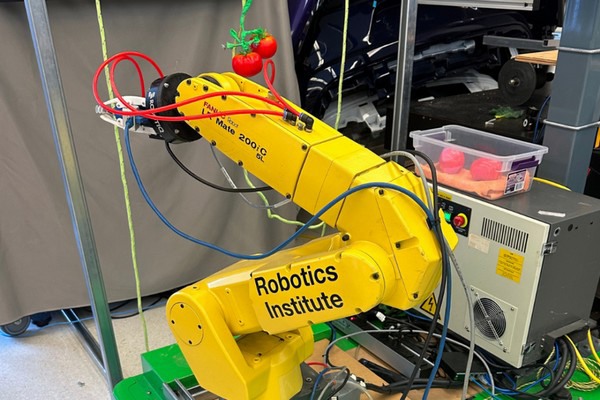At Dr. Medhat Moussa's laboratory in the University of Guelph's School of Engineering, a yellow-armed robot stands on a platform facing a model tomato plant. It cranes toward the tomato when the start button is clicked.
The robot examines the plant with embedded cameras, tilting its head as if "thinking" with its machine vision algorithm. It grabs the tomato with finger-like grippers and sets the product perfectly into a bin.
This latest iteration of Guelph Intelligent Greenhouse Automation System (GIGAS), a smart robot developed at The Robotics Institute @ Guelph, harvests tomatoes using AI-powered vision and an innovative gripping system. It uses deep learning and an image database to identify the tomato amidst environmental obstacles and to figure out how to grab it from the vine.
The U of G-developed technology was recently showcased to Ontario Premier Doug Ford and Ontario Minister of Colleges and Universities Jill Dunlop, who heard how GIGAS's automation power could soon support difficult greenhouse working conditions and agricultural labor shortages.
The need for advanced agriculture technology is critical. A recent report from the Canadian Agriculture Human Resource Council predicts that one-third of the agricultural workforce will retire by 2030, leaving more than 100,000 jobs needing to be filled.
Innovative technology, according to the report, could be a crucial solution to tackling this chronic labor shortage, and the University of Guelph is leading the charge.
U of G is leading smart robotics
"I would say U of G is ahead in smart robotics for greenhouses and harvesting," project lead Moussa says. "We started this project in 2010. Now, we're ahead of other universities and even industry. This is a very challenging problem, and you'd be hard-pressed to find a robot that's actually being sold for this application."
Research associate Cole Tarry stands by to give a demonstration, having worked on this project for several years.
"No other research lab that we know of is working on robotics for beefsteak tomatoes, which are generally the most difficult to work with," Tarry adds. "The robots closest to commercialization work with cherry tomatoes or cucumbers."
There are other applications to the technology being developed in the lab. It could be trained to harvest other vegetables, such as peppers and cucumbers. Those are the other two major crops in Leamington, Ont., where this project was first inspired by growers who urged the development of automated solutions.
For more information:
University of Guelph
Email: [email protected]

